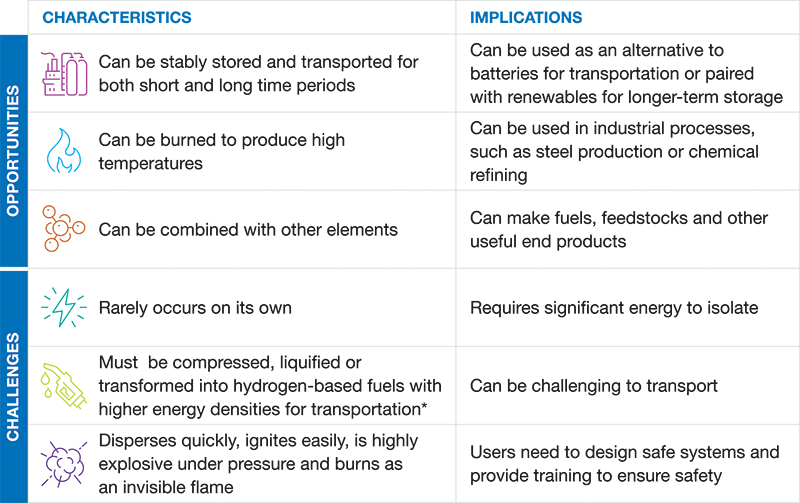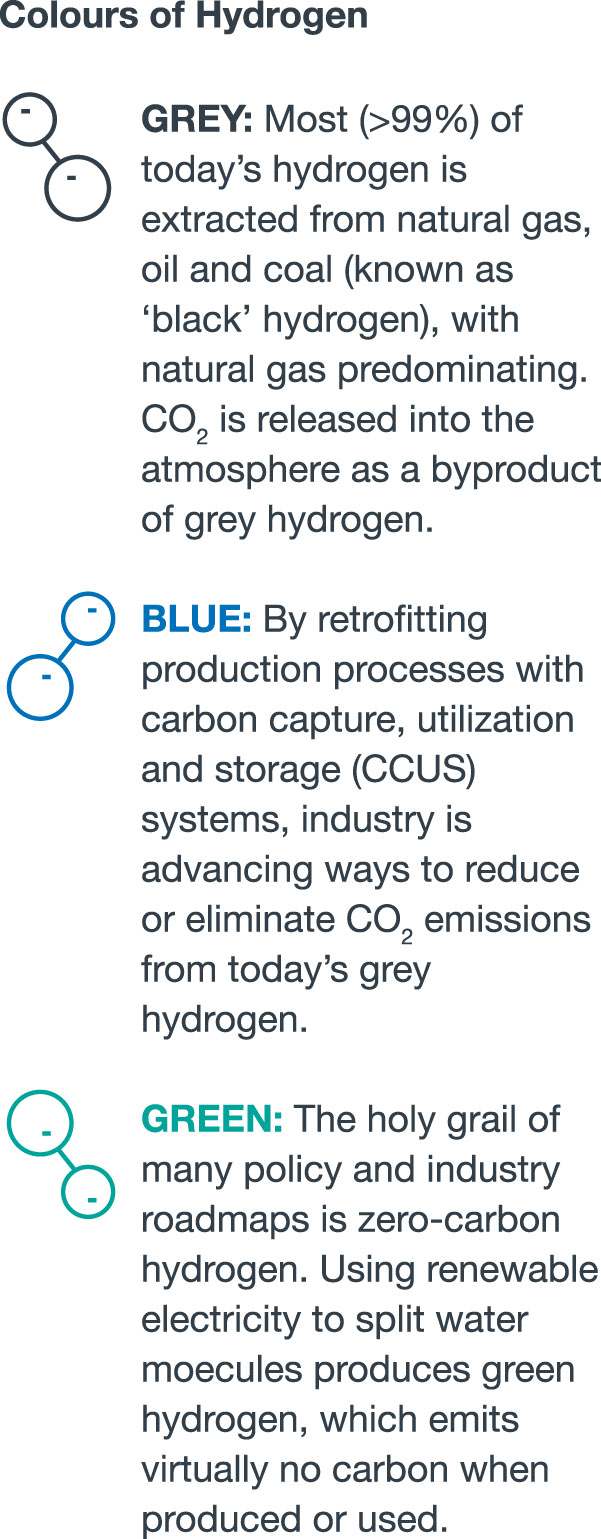
Hydrogen’s new moment
The universe’s most abundant element has long been considered a potential alternative to traditional forms of fuel. However, until now, the cost barriers associated with hydrogen production were too high to make it a viable zero-carbon fuel source. The introduction of favourable climate-change policies, declining costs and growing use cases have resulted in renewed interest in hydrogen.

Policy makers are increasingly backing hydrogen as a zero-carbon fuel, helping to push down costs and prime demand.
Hydrogen has transfixed the energy world since the 1970s, when scientists first began hunting in earnest for carbon-free alternatives to petroleum. And for good reason. Hydrogen is the most abundant element in the universe and can be produced wherever there’s water and electricity — without carbon emissions or toxic pollution. Per unit of weight, it’s potent, delivering three times the energy of gasoline, diesel or jet fuel.1
For all its promise, though, hydrogen has been stymied by a tangle of disadvantages. Hydrogen may be plentiful, but it only rarely occurs on its own and requires significant energy to isolate. It’s also such a light gas that storing and transporting it requires high pressurization and costly engineering. Recurring attempts to make hydrogen a viable fuel source — including a flurry of enthusiastic activity in the early 2000s — failed to overcome the cost barriers, and so the world moved on.2
We believe it’s time to take another look at hydrogen. Recently, CPP Investments surveyed the hydrogen economy and uncovered three factors giving rise to renewed corporate and investor interest: proliferating climate-change policies, falling production prices driven by improved technologies and the promise of large-scale industrial demand.
Hydrogen’s promise comes with challenges

*H2 has the lowest density per unit volume of any element

The world gets serious about climate change
The growing urgency to address climate change is rebalancing the calculus around hydrogen. Today, the single most powerful driver in the global push for clean hydrogen is coming from governments eager to develop a zero-carbon fuel. While earlier efforts to harness hydrogen power focused narrowly on passenger vehicles and paid scant attention to their carbon intensity, today’s wave of government support is larger in scale and broader in ambition, aimed at building a low-carbon energy ecosystem capable of supplying multiple sectors, including heavy industry, power and transport.
This push builds on an established foundation. Hydrogen is already used widely in heavy industry as both a fuel source and a raw material. Nearly all the hydrogen used today, however, is “grey” hydrogen, extracted from fossil fuels in processes that emit CO2. The current push for hydrogen is fueled by new technologies that promise to produce large volumes of zero-carbon “green” hydrogen at lower costs than was previously feasible.
These advances have driven a surge in public and private investment. Post-COVID stimulus spending in Europe prioritizes the production of green hydrogen. In Asia, governments are likewise setting long-term goals, priming demand and funding research. Even in advance of expected U.S. support, global investment is scaling quickly. The EU’s Green Deal, which targets a 55% reduction in emissions by 2050, foresees up to €550 billion in spending on a continent-wide supply chain for green hydrogen. 3
Canadian governments are also showing their support. The federal government launched its national hydrogen strategy in December, underpinned by a government-funded capital pool designed to increase the production and use of low-carbon fuels, including hydrogen.4 In Alberta, the provincial government last year discussed the goal of large-scale hydrogen production through the combination of natural gas and carbon capture, utilization and storage (CCUS).5
Additionally, this month, Canada and Germany agreed to work together to support the development of the hydrogen industry. This could one day lead to green hydrogen made from Canadian hydroelectric power being exported to Germany.6

Technological improvements and scale are driving down costs
It’s not just supportive government policies that are propelling the interest in hydrogen. Rapid technological advancements are pulling down prices. The cost to produce green hydrogen is largely a function of two factors: the electricity needed to split water molecules, and the price of the electrolyzer in which that alchemy happens. Costs are falling for both factors, rapidly re-writing once-prohibitive pricing models for generating hydrogen.
Cost to produce green hydrogen is largely a function of two factors:
1. electricity to split water molecules
2. price of electrolyzer
- Renewables have an edge over conventional ways of generating electricity: rapidly declining costs. Due to steadily falling costs for equipment and installation, renewables are now cheaper than the lowest-cost form of fossil-fuel generation in many markets.7 The upshot: a spectacular boom in renewable-energy capacity and ongoing price declines.8 Using cheap renewables to create hydrogen results in a fuel that can substitute for many fossil fuels. What’s more, hydrogen can be stored in large volumes and converted back to electricity to cost-effectively power the grid when renewables are offline, with water being the only waste product.
- Electrolyzer costs are poised to plummet. By using electricity to split hydrogen out of water, these chemical reactors will go from a niche specialty market to industrial-volume production. In the process, economies of scale and efficiency gains will combine to cut costs by upwards of 70% by 2050.
- As prices fall, green hydrogen is on track to match the price of grey in most geographies by 2050, though there will be regional variations. In Australia, which is blessed with ample solar and wind resources, very low-cost renewable energy could help green hydrogen match grey’s price, absent any carbon taxes, by 2030. On that timeline, Europe would need to increase carbon taxes to US$50–to–US$150 per ton to hit parity.
- Investment in hydrogen infrastructure promises to drive down costs as well. To ship or store hydrogen in large quantities, it must be chilled to ultra-cold temperatures and/or be highly pressurized.9 Ships, tanks and pipelines must be specially engineered to resist hydrogen’s tendency to embrittle commonly used metals. As production of these specialized materials rises, efficiencies and scale should lower costs.




New end uses are emerging
As green hydrogen becomes more affordable, new use cases are emerging across a wide mix of industries, just as many sectors are seeking to decarbonize in the face of rising pressure from regulators, investors and consumers. These include a set of industries that, so far, have found few good alternatives to fossil fuels: industrial processes, natural gas networks, trucking and related infrastructure.
- Heavy industry is already a big user of grey hydrogen. As such, substituting in blue, and eventually green, hydrogen would be relatively non-disruptive, with minimal need to alter industrial processes or supply chain sourcing practices. For example, large volumes of hydrogen are required to synthesize ammonia, a critical precursor to fertilizer. The steel, refining and methanol industries are also considered candidates for adopting green hydrogen.10
- Since it burns similarly to natural gas, blending hydrogen into existing natural gas networks could be a growth market, for end uses such as cooking, heating and power generation. The carbon benefit varies by the amount of green hydrogen used to displace natural gas, with a limit of around 20%, beyond which equipment must be upgraded.
- Electric utilities could decarbonize via blending as well. Even as renewables’ share of the grid rises, natural gas peaker plants are likely to persist, filling in for natural dips in output from wind turbines and solar panels. Some natural gas power plants can already burn hydrogen blends, and more U.S. and European utilities are retrofitting facilities to do so.
- Further out, electric utilities are keen on hydrogen as a way to store renewable power. Operators of wind and solar farms are already wrestling with periods when production exceeds demand. Today, with nowhere to sell that surplus, they sometimes curtail production. Utilities could instead use the surplus to generate and store large volumes of green hydrogen. Days or weeks later, in the evenings when power prices are highest and renewables output often drops, the hydrogen can then be transformed back into electricity via fuel cells or turbines, or even converted into synfuels.
- In the race to displace gas and diesel in passenger cars, battery-based systems are winning. But for heavy trucks, hydrogen is well positioned. To power a loaded truck over long distances, batteries become too heavy and costly, and can take a long time to recharge. Hydrogen fits this niche nicely. By replacing batteries with hydrogen tanks linked to a fuel cell, trucks can access ample power over long ranges and refuel quickly. Heavy vehicles of all sizes — from delivery vans to buses and 18-wheelers — are big CO2 emitters, and so are a top target for carbon reduction.

Investment Outlook
At CPP Investments, we see a diverse set of opportunities, many offering multi-decade, multi-sector growth potential. Investments could fund hydrogen production, distribution and use — including the supply chains to manufacture electrolyzers and fuel cells — as well as hydrogen transportation, storage and refueling stations, to name a few. Morgan Stanley predicts investment of ~US$5.4 trillion in electrolyzers, including related spending on infrastructure by 2050.11
To be sure, not every sector will pan out. Tesla CEO Elon Musk has famously dismissed hydrogen’s promise in transportation. His critique? Compared to simply storing renewable electricity in a battery, the hydrogen loop — converting renewable electricity into hydrogen via an electrolyzer, then reconverting that hydrogen back into power via a fuel cell — is comparatively costly and inefficient. Sure enough, this complexity has made fuel cells uneconomical for passenger cars.
Yet as we step back, hydrogen emerges as a player in a much bigger historical perspective, one where every century or so, an incumbent energy source gives way to a better replacement. In the 1800s, wood was displaced by coal, which could do more work. In the 1900s, coal gave way to oil, a more versatile and cleaner option. In the 2000s, zero-carbon electricity will likely overtake oil and natural gas, with hydrogen used as a multipurpose storehouse.12
Energy expert and Pulitzer Prize–winning energy historian Daniel Yergin describes this unfolding transition as ‘history curving.’ As climate change intensifies, and the world bends away from carbon, we believe it will bend towards zero-carbon fuels — including hydrogen.13
Facts and figures are proprietary to CPP Investments unless otherwise stated.
This work reflects thinking from a joint initiative led by our Thematic Investing and Energy & Resources teams with Fund-wide input.
Sources
- BloombergNEF. Separating Hype from Hydrogen – Part One: The Supply Side.
- Ibid.
- Ibid.
- Natural Resources Canada. Hydrogen Strategy for Canada: Seizing the Opportunities for Hydrogen A Call to Action.
- Government of Alberta. Natural Gas Vision and Strategy.
- Reuters. Germany, Canada agree to explore green hydrogen development.
- Bloomberg. Renewable power will soon come out on top.
- BloombergNEF. BNEF Executive Factbook.
- Op. cit. BloombergNEF. Separating Hype from Hydrogen – Part One: The Supply Side.
- International Energy Agency. The Future of Hydrogen Report: Seizing Today’s Opportunities. Prepared by the IEA for the G20, Japan.
- Morgan Stanley. Decarbonization: The Race to Net Zero.
- Smil, Vaclav. Energy Transitions: History, Requirements, Prospects. Santa Barbara, CA: Praeger, 2016.
- Axios. Biden ushers in historical turn on clean energy and climate change.







